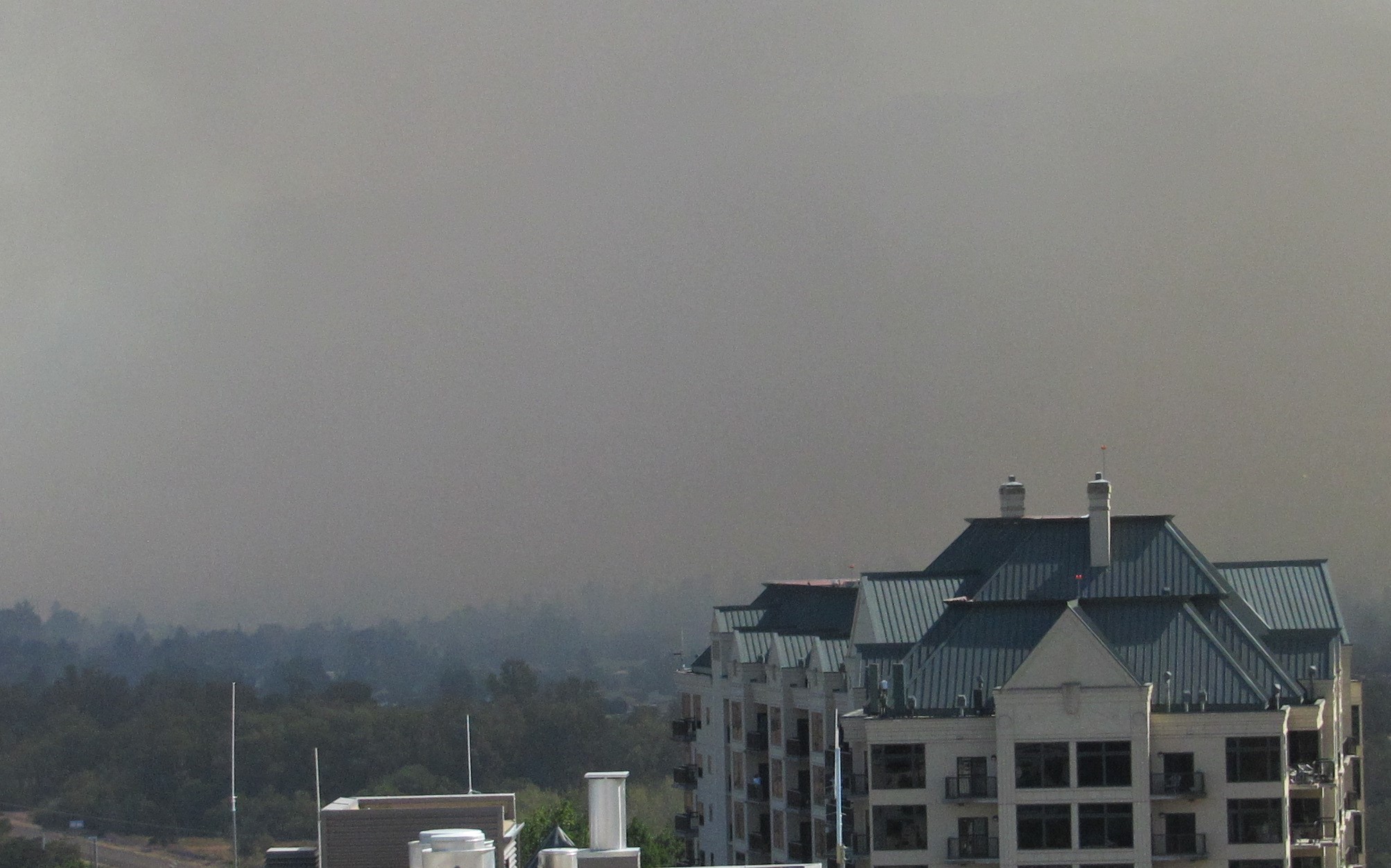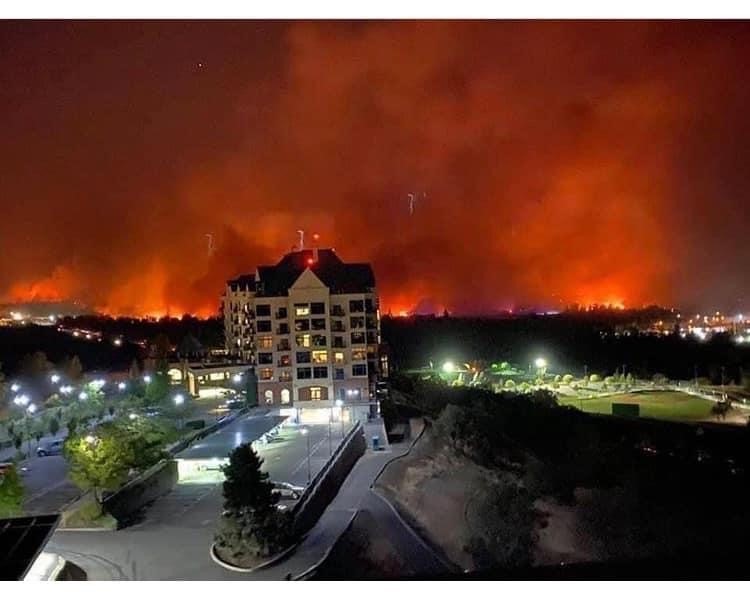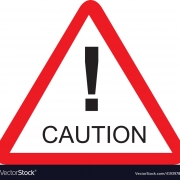‘Tis the Season to be…ALERT!
by Bob Buddemeier
Now that most of us are worrying less about COVID, we can focus some of that nervous energy on the next larval disaster waiting in the wings.
It is Wildfire Season and it promises to be long, hot, dry, and dangerous. The chances are good that we will experience some kind of fire-related problem(s). Fortune favors the prepared: get ready now and suffer less later.
General emergency and preparedness information can be found on the myRVM Emergency Preparedness page and at https://thecomplement.info/prepare/, the Resident Preparedness Group webpage. Specific sources will be mentioned below.
 SMOKE is the most probable impact. The valley we live in is an extremely effective air pollution trap, and if there is a major fire halfway close to us the air quality is likely to become poor, or very bad, or off-scale-hazardous. When that happens, it will probably last for days, and maybe weeks.
SMOKE is the most probable impact. The valley we live in is an extremely effective air pollution trap, and if there is a major fire halfway close to us the air quality is likely to become poor, or very bad, or off-scale-hazardous. When that happens, it will probably last for days, and maybe weeks.
It’s not good for anybody, but people with respiratory problems really need to prepare and protect.
To prepare: 1. If you can go away, plan to do so. 2. Stock up on N95 or KN95 masks – not the COVID blue paper or designer kinds. 3. If you need/want room air purifiers, get them now. 4. Other supplies – food and household goods to minimize outside trips, tape to seal leaky door or window joints, etc.
When it happens: 1. If possible, leave the area (air quality websites — some with forecasts — can help you decide where to go: https://oraqi.deq.state.or.us/home/map, https://gispub.epa.gov/airnow/). 2. Stay inside with house tightly closed. 3. Run the AC fan continuously. 4. If you must go outside, wear a mask; if conditions are really bad wear it inside too. 5. Run air purifiers if you have them.
POWER OUTAGES are common side effects of wildfires, either because of fire damage to the electrical infrastructure, or because of precautionary shutdowns by power companies. In either case, duration may be hard to predict.
Protracted power outages are about much more than having enough flashlight batteries; they affect most aspects of life. Commerce is disrupted (no ATMs, cash registers or internet), communications break down, and electrical equipment can’t be operated (including safety and security gear and home medical devices).
For RVM-specific information, see “Power Outage Information” on the myRVM Emergency Preparedness page, or download here. The effects of extended power outages are addressed as part of the earthquake preparedness material in https://thecomplement.info/prepare/ — see especially Light and Electricity.

FIRE is the least likely but most devastating direct impact, and as the Almeda Fire of 2020 showed, it is a very real possibility. It is challenging to prepare for and respond to, because it will probably require evacuation and a quick response. Whether the evacuation is off-site and long-term or local (e.g., cottage residents sheltering in the more fire-resistant high-rises), evacuees will need to take some critical basic possessions with them.
To prepare: 1. Each individual needs to have a basic, minimum go-bag that he or she can carry easily. Even if it only weighs a pound or two it can contain identification, money, contact information, medical information and medicines, and a few personal hygiene and or survival items (e.g., toothbrush, small flashlight). 2. This can be a component of a larger go-bag for the individual or couple, containing additional personal gear, clothing, some food and first aid supplies, etc., but the per-person-portable bag is critical – see pages on go-bags, documents, and medications. 3. If you have a car, make sure to keep the tank at least half-full and stock it with emergency supplies appropriate for storage in a vehicle. 4. Become familiar with the kinds of emergency information you may receive, and how it will arrive – TV, internet, landline, cell phones, neighbor – and enroll in the available emergency notification services.
When it happens: Fire emergencies typically progress through stages as the fire draws closer.
Evacuation Alert Level 1 – Get ready. Open your garage door if you have one (see additional information below). Get your basic go-bag and other must-take items (wallet, keys, cell phone) together and ready to go. Dress appropriately for ‘roughing it.’ Complete your big go-bag and assemble other items you need or want to take along (e.g., pet supplies).
Evacuation Alert Level 2 – Get set. If you have a car, load everything into it. If not, have what you can carry assembled, packed, and ready to go; other take-alongs should be compactly packed for transport by others (if available).
Evacuation Alert Level 3 – Drive or walk to the designated assembly point or destination, following the directions of RVM staff and/or law enforcement.
+++++++++++++++++++++++++++++++++++++++++++++++++++++++++++++++++++++++++++++++++++++
Additional information
One of the first recommended actions for Alert Level 1 is to open your garage door – and if you can park the car nearby without impeding traffic, to take it out of the garage. In the Almeda fire evacuation, part of campus lost power, and people had difficulty getting the garage doors open.
RVM is systematically replacing the springs in the cottage garage door openers. According to Rick Ramirez of Facilities Services, the originally-installed springs were incorrect, and resulted in the doors being excessively hard to open when the power was off. The changeover should substantially improve that; however, it will not be completed for the current fire season. Work started in the 1100 block and has progressed to the middle of the 1200 block, but Rick says that it may be December before all of the cottage garages are upgraded. The work is slow, and complicated by the fact that differences in original equipment are encountered.
Residents can form neighborhood teams to help each other (a good idea in any case!) or take some of the simple do-it-yourself steps to make opening a power-off door easier.
Cottage residential areas are divided into Areas (a total of 11) and neighborhoods (2 to 4 within each Area). In the high rises, Floors and Building Sectors are analogs of the Neighborhoods and Areas. Residents’ Preparedness Group volunteers serve as coordinators within each grouping (Neighborhoods/Floors and Areas/Building Sectors). Their primary role is to support RVM emergency preparedness and response by providing direct communication with residents, and to assist in building resident preparedness at the individual and community level



Leave a Reply
Want to join the discussion?Feel free to contribute!